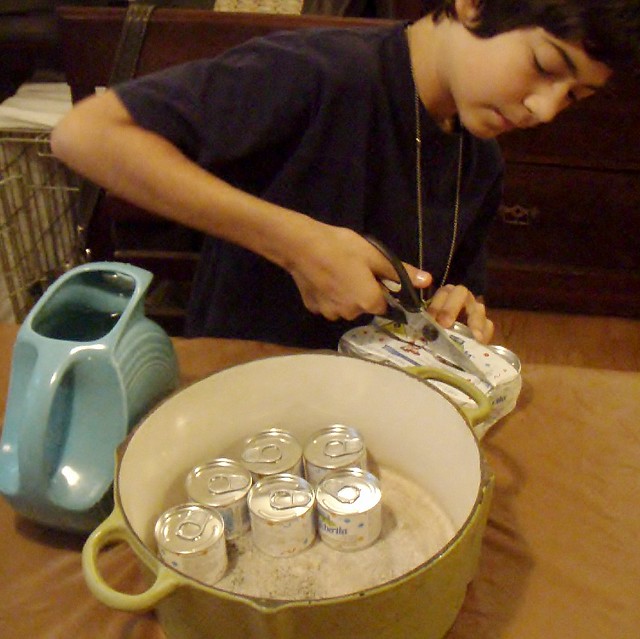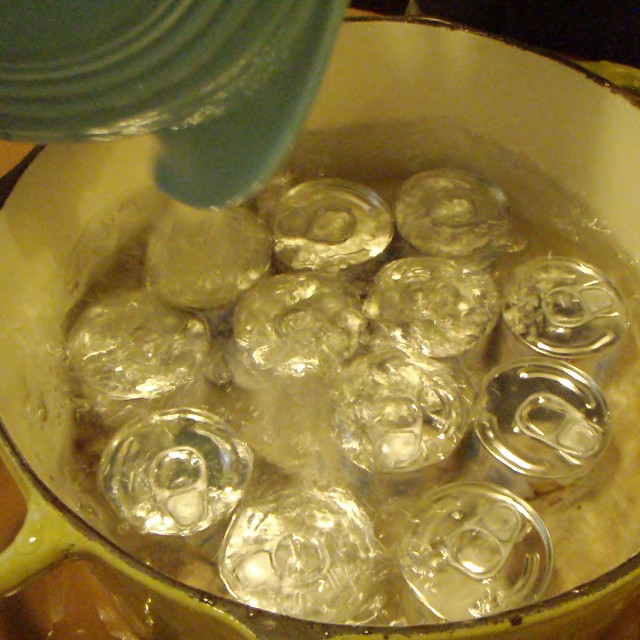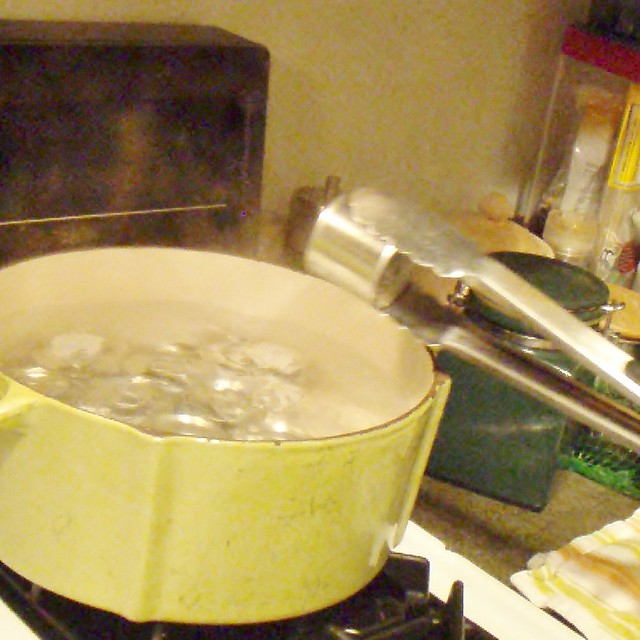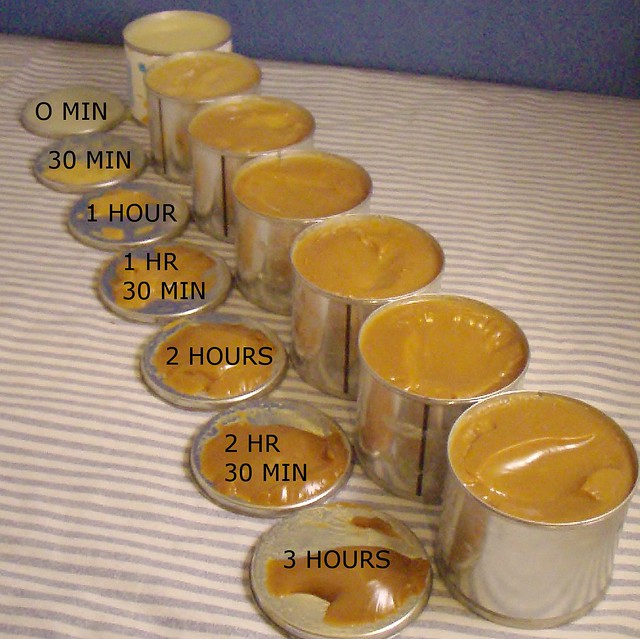Dulce de leche is a two-ingredient recipe no matter how you look at it. You can make it from "scratch" by boiling milk and sugar into caramel, whisking for hours, or you can boil unopened cans of sweetened condensed milk - very carefully, because if you boil the water off the tops of the cans, they might overheat and explode (dramatic as this sounds - I have never seen this happen in many, many years of making it this way. Of course, we were always careful with the water level.) These two methods take advantage of the same chemical reaction: the Maillard reaction.
Even though we are producing something like caramel, the Maillard reaction is not the same as caramelization. 100 years ago, physician and scientist Louis-Camille Maillard discovered this reaction in his study of "reducing sugars" - complex sugars that give up charged atoms to other particles in certain situations. Maillard uncovered a specific reaction that happens when a reducing sugar and a protein (proteins contain nitrogen) are exposed to heat around room temperature or slightly higher. Basically, this change gives our food a boost of color, flavor and aroma. Because the condensed milk (a combination of proteins and sugars, right?) remains in a sealed environment and is heated at a temperature near the boiling point, we can conclude that the Maillard reaction causes the change. This same reaction causes everything from bread to steak to fried chicken to become GBD. It is so beloved, it even has its own international society.
Carmelization, on the other hand, is all about applying heat to sugar, any sugar - it's the reaction that brings us things like toffee and peanut brittle. It happens at a much higher temperature - about 250 to 350° F, and is what distinguishes Dulce de Leche from a Caramel Sauce, (in which you add cream to a hot and already-caramelized sugar.) I do notice that though the two sauces are similar, they are not identical.
So, in this experiment, we will be controlling several variables: one, the contents of the can (controlled by the can itself) two, the application of even heat (boiling in a water bath will keep a constant temperature) and we will be manipulating one variable: time. My mother always boiled her Dulce de Leche for several hours, and I always wondered whether that was truly necessary. We are making one change from her recipe, simply for convenience's sake: I am using "La Lecherita," tiny six-packs of 3.5 ounce cans of sweetened condensed milk. Our findings may not apply to a larger can.
 Sparky emptied two packages of La Lecherita into our Dutch Oven (an excellent choice for this task on two parts: it has a lid that seals tightly and it is made of a material that retains heat well.) Keep in mind that the most important factor in a cooking vessel right now is depth, and ordinarily this pot would be too shallow - but since we're using tiny cans, it was easy to cover them in double their depth of water, which was the next thing Sparky added to the pot.
Sparky emptied two packages of La Lecherita into our Dutch Oven (an excellent choice for this task on two parts: it has a lid that seals tightly and it is made of a material that retains heat well.) Keep in mind that the most important factor in a cooking vessel right now is depth, and ordinarily this pot would be too shallow - but since we're using tiny cans, it was easy to cover them in double their depth of water, which was the next thing Sparky added to the pot.  You want to keep the cans covered by water during the entire cooking process, because the water is how we maintain a constant temperature of 212 Farenheit or 100 Centigrade; if it boils away your cans can overheat - and we don't want to find out what happens then, scientific curiosity or no. This means you have to account for water loss via evaporation - more water is better.
You want to keep the cans covered by water during the entire cooking process, because the water is how we maintain a constant temperature of 212 Farenheit or 100 Centigrade; if it boils away your cans can overheat - and we don't want to find out what happens then, scientific curiosity or no. This means you have to account for water loss via evaporation - more water is better. We brought the water to a rolling boil, covered the pot, and turned down the heat to the lowest point where we could still hear the cans doing their "dance" inside the pot (BONUS SCIENCE QUESTION: Who can explain what causes the cans to "dance" in the comments? Extra points if you are answering for someone in grades K-12) We set a timer for 30 minutes, and went about our business.
We brought the water to a rolling boil, covered the pot, and turned down the heat to the lowest point where we could still hear the cans doing their "dance" inside the pot (BONUS SCIENCE QUESTION: Who can explain what causes the cans to "dance" in the comments? Extra points if you are answering for someone in grades K-12) We set a timer for 30 minutes, and went about our business. In 30 minutes, Sparky pulled out two cans, set them aside to cool, checked the water level of the pot, re-covered it, and set the timer for another 30 minutes. We repeated this 6 times for a final cooking time of 3 hours, adding water to the pot as needed. We allowed each can to cool completely, and then opened them to take a look at the results.
In 30 minutes, Sparky pulled out two cans, set them aside to cool, checked the water level of the pot, re-covered it, and set the timer for another 30 minutes. We repeated this 6 times for a final cooking time of 3 hours, adding water to the pot as needed. We allowed each can to cool completely, and then opened them to take a look at the results.Longtime friend of QTBO, Professor Subha Ranjan Das, (who will hopefully check that I got this right) sent us some leads on better insight into the Maillard reaction: There are three main stages to this process - condensation, rearrangement, and polymerization. The first two stages don't produce much visual change at all - you can see this in the can that only cooked for 30 minutes - it's barely changed color from the uncooked can. On the molecular level, however, the sugar and an amino (the nitrogen compound in proteins) combine to make an unstable compound called an n-substituted glycosylamine. In a process known as the Amidori rearrangement, the oxygen and hydrogen atoms rearrange themselves into water molecules; what remains becomes an Amidori compound. These two reactions have little effect on the color of the mixture - but if you open the can and take a whiff at this point, you may begin to smell the effect. The tail end of this reaction produces volatile compounds that give us the the sugary, malty smell we associate with caramel. The unstable compound continues to degrade, until finally the remaining loose molecules recombine into long, stringy polymers, which bring the brown color and some tasty, tasty flavors. Unlike true caramelization, the Maillard reaction doesn't require much heat, which is why milk makes an excellent invisible ink: it will turn brown before paper scorches.
Interestingly, while the difference between the first can and the last can is marked, the difference in color of the last three cans is pretty much the same. Therefore, our experiment can be said to show that 2 hours is sufficient time to boil a tiny can of condensed milk into golden-delicious Dulce de Leche.
We made some toast, and the rest is history. Enjoy!








6 comments:
Cans 2-4 also look yummy. How did they turn out? Also, the last can looks a bit darker than the previous two. Was there any difference?
I will admit that in the final analysis, we dumped cans 2-6 in a mason jar and mixed it all up; the mixture tastes like Dulce de Leche to me!
I did note that all the cans that had been boiled changed gradually in texture - you can see this gradation best in the stuff that clings to the lids (the smell also changed, as noted.)
While there was a very slight difference in the color of the last three cans, it is more pronounced in the photographs than it was IRL. (I wish I had a reflectometer, so I could get exact readings.)
What a great project! I would have liked science more if experiments concluded with something sweet and edible.
Thanks, Mary!
En mi casa ni madre también hacia de vez en cuando latas de leche condensada hervidas . Nos encantan a todos en casa.
I need to know exactly what kind of tea you Mum drank with her afternoon snack. Thank you
Post a Comment